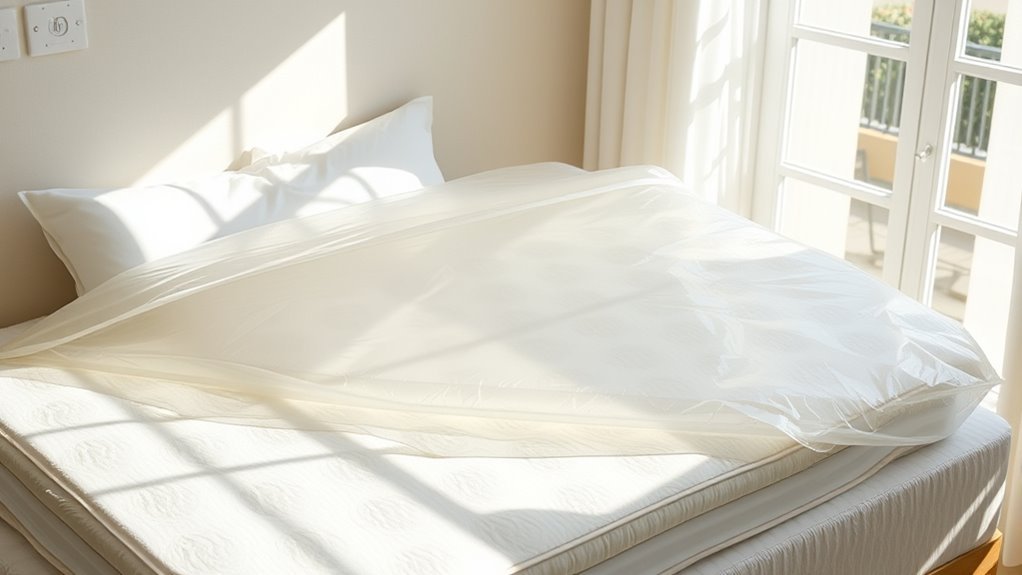To protect your cotton mattress from dust mites during storage, first, clean it thoroughly by vacuuming and spot cleaning. Use a breathable, zippered protective cover to keep dust and moisture out. Store the mattress in a cool, dry place with low humidity, ideally between 30-50%. Airtight containers are also beneficial. Consider using natural dust mite repellents like essential oils or diatomaceous earth for extra protection. There’s more to discover about effective storage techniques!
Choose the Right Protective Cover
When it comes to protecting your cotton mattress from dust mites, choosing the right protective cover is essential. Start by considering the mattress materials; a breathable cover made from cotton or polyester blends can help maintain airflow while keeping dust mites at bay. Look for cover types that are waterproof or water-resistant, as they can offer additional protection against moisture, which dust mites thrive in. Zippered encasements are ideal, as they fully encase the mattress, preventing mites from entering or escaping. Make certain the cover is machine washable for easy maintenance. By selecting the appropriate cover, you’re not only enhancing your mattress’s longevity but also guaranteeing a healthier sleeping environment, giving you the freedom to enjoy restful nights without worry.
Clean Your Mattress Before Storage
Before storing your cotton mattress, it’s essential to clean it thoroughly. Start by vacuuming the entire surface to remove dust and allergens, then spot clean any stains you find. This simple process will help protect your mattress from dust mites while it’s in storage.
Vacuum Thoroughly First
To guarantee your cotton mattress is protected from dust mites, it’s essential to start by vacuuming it thoroughly. Use effective vacuum techniques, like an upholstery attachment, to reach every nook and cranny. Focus on the seams and edges, where dust mites tend to accumulate. This step is critical in your mattress preparation, as it removes not just dust but also allergens, ensuring a cleaner storage environment. Make sure to vacuum both sides of the mattress for maximum effectiveness. If your vacuum has a HEPA filter, even better—it’ll trap tiny particles more efficiently. Once you’ve finished vacuuming, you’ll have a much better foundation for protecting your mattress from dust mites during storage. Take this simple step seriously for ideal protection.
Spot Clean Stains
After vacuuming your cotton mattress, addressing any stains is the next important step. For effective stain removal, start by identifying the type of stain—whether it’s from food, drink, or bodily fluids. Use appropriate cleaning solutions: a mixture of mild detergent and water often works well. Dampen a clean cloth with the solution, and gently blot the stain—avoid rubbing, as this can damage the fabric. Rinse the area with a damp cloth to remove soap residue, and then blot dry with a towel. Allow the mattress to air dry completely before storage to prevent mildew. By spot cleaning effectively, you not only maintain your mattress’s integrity but also guarantee a healthier sleeping environment when you’re ready to use it again.
Maintain Optimal Humidity Levels
To protect your cotton mattress from dust mites, maintaining ideal humidity levels is essential. Ideally, you should keep indoor humidity between 30% and 50% to discourage mite growth. Use dehumidifiers wisely and monitor humidity with a hygrometer to guarantee you’re within this range.
Ideal Humidity Range
Maintaining the ideal humidity range in your bedroom is essential for keeping dust mites at bay, as these tiny pests thrive in damp environments. Aim for a humidity level between 30% and 50%. This range not only helps with humidity control but also minimizes moisture absorption by your cotton mattress and bedding. You can check humidity levels using a hygrometer, which provides accurate readings. If you find that humidity exceeds this range, consider using moisture-absorbing materials like silica gel packets or placing your mattress in a well-ventilated area. Remember, keeping humidity in check is a straightforward way to create a more comfortable and healthier living space, free from unwanted dust mites. Stay proactive and enjoy a restful environment!
Use Dehumidifiers Wisely
When humidity levels exceed the ideal range, using dehumidifiers can be an effective solution for maintaining a comfortable environment. Proper dehumidifier settings are essential for efficient moisture control. Aim for a relative humidity of 30-50% to keep dust mites at bay and protect your cotton mattress during storage.
| Dehumidifier Setting | Recommended Humidity Level |
|---|---|
| Low | 50% or below |
| Medium | 40% |
| High | 30% or below |
Monitor With Hygrometer
Monitoring humidity levels is essential for preventing dust mites from thriving in your cotton mattress. To achieve effective humidity control, invest in a hygrometer. This handy device allows you to keep an eye on moisture levels in your storage space. Ideally, you want to maintain humidity below 50%, as higher moisture fosters dust mite growth. If you notice humidity creeping up, consider using a dehumidifier or moisture-absorbing products to keep levels in check. Regular moisture monitoring will not only protect your mattress but also contribute to a healthier storage environment. Remember, staying proactive about humidity can help guarantee your cotton mattress remains free from unwanted pests and fresh for when you need it again.
Store in a Cool, Dry Place
One key factor in protecting your cotton mattress from dust mites is storing it in a cool, dry place. Maintaining proper ventilation and temperature control is crucial in preventing moisture buildup, which can attract dust mites. Here’s a quick guide to help you choose the right environment:
| Environment Type | Ideal Conditions |
|---|---|
| Indoor Storage | 60-70°F, low humidity |
| Outdoor Storage | Avoid direct sunlight, shaded area |
| Storage Units | guarantee climate control options |
Use Airtight Storage Containers
Storing your cotton mattress properly is vital, and using airtight storage containers can greatly enhance its protection against dust mites. Choose containers with airtight seals to guarantee that no moisture or allergens can penetrate. This helps maintain a clean, dust-free environment that’s essential for your mattress’s longevity. You can also consider heavy-duty storage bags designed specifically for mattresses; they provide an extra layer of protection while being easy to handle. When sealing your mattress, make sure to completely remove any air to prevent mold and mildew growth. By utilizing these airtight options, you’ll keep your mattress in pristine condition and ready for use whenever you decide to reclaim your space. Enjoy the freedom of a dust-free mattress!
Regularly Check on Your Mattress
Regularly checking on your mattress is essential for maintaining its condition and preventing dust mite infestations. Schedule a mattress inspection at least once a month to guarantee it’s free from moisture, pests, or any signs of wear. During your routine maintenance, look for any discoloration, odors, or unusual textures that might indicate a problem. If you find any issues, take action immediately—clean it or consider professional help if necessary. Don’t forget to inspect the storage area as well, as dust and humidity can accumulate there, affecting your mattress. By staying proactive with your mattress inspections, you can enjoy peace of mind knowing your cotton mattress remains in top shape, ready for use when you need it.
Avoid Stacking Heavy Items on Top
To keep your cotton mattress in ideal condition, it’s essential that you avoid stacking heavy items on top. Excess weight can lead to permanent indentations and affect the mattress’s weight distribution, compromising your comfort when you use it again. Here’s a simple guide to help you understand the impact of mattress stacking:
| Item | Impact on Mattress |
|---|---|
| Heavy boxes | High pressure points |
| Furniture | Permanent deformation |
| Electronics | Uneven weight distribution |
| Seasonal items | Potential moisture retention |
| Miscellaneous clutter | Increased wear and tear |
Consider Using Natural Dust Mite Repellents
While dust mites thrive in warm, humid environments, you can effectively deter them by using natural repellents. Consider incorporating essential oils like eucalyptus, lavender, or tea tree oil into your storage routine. These oils possess properties that repel dust mites and can create a pleasant scent. You can mix a few drops of your chosen essential oil with water in a spray bottle and lightly mist your cotton mattress before storing it. Additionally, natural remedies like diatomaceous earth can be sprinkled around the mattress to absorb moisture and inhibit dust mite growth. Remember to reapply these treatments periodically for continued protection. By using these natural options, you can enjoy a dust mite-free mattress, allowing you to breathe easier during storage.
Frequently Asked Questions
How Long Can I Store a Cotton Mattress Before It Deteriorates?
You can typically store a cotton mattress for about six months to a year without significant deterioration, provided you maintain proper storage conditions. Keep it in a cool, dry place away from direct sunlight to maximize mattress longevity. Avoid placing heavy items on top and guarantee it’s covered to protect against dust and moisture. Storing it correctly will help you enjoy your mattress for years to come when you’re ready to use it again.
Can I Use Plastic Wrap for Mattress Storage?
Using plastic wrap for mattress storage might seem like a quick fix, but is it really the best choice? While it offers some mattress protection, it can trap moisture, leading to mold and mildew. Instead, consider breathable storage solutions like mattress bags designed for airflow. They provide protection from dust and pests without compromising the mattress’s integrity. Ultimately, keeping your mattress dry and clean is key to preserving its quality during storage.
Is It Safe to Store My Mattress in a Basement?
Storing your mattress in a basement isn’t ideal due to basement humidity, which can lead to mold and mildew. If you must, make certain there’s proper mattress ventilation by elevating it off the floor and using a breathable cover. This’ll help reduce moisture exposure. Consider using a dehumidifier to manage humidity levels. Taking these precautions can help keep your mattress in good condition while stored, giving you peace of mind for future use.
What Are Signs of Dust Mite Infestation in Stored Mattresses?
Signs of dust mite infestation in stored mattresses include allergic reactions like sneezing, itchy eyes, or skin rashes. You might also notice a musty odor or dark spots on the mattress. For a thorough mattress inspection, check for these symptoms and look closely for any signs of mold or excessive moisture, which can attract dust mites. If you find any indications, it’s essential to address them promptly to guarantee your mattress remains safe and clean.
Can I Use Essential Oils to Repel Dust Mites?
Yes, you can use essential oils to repel dust mites effectively. Oils like lavender and eucalyptus have essential oil benefits that help in dust mite prevention. Simply mix a few drops with water in a spray bottle and lightly mist your mattress before storage. This not only creates a barrier but also adds a pleasant scent. Just remember to reapply occasionally to maintain their effectiveness and keep unwanted pests at bay.



